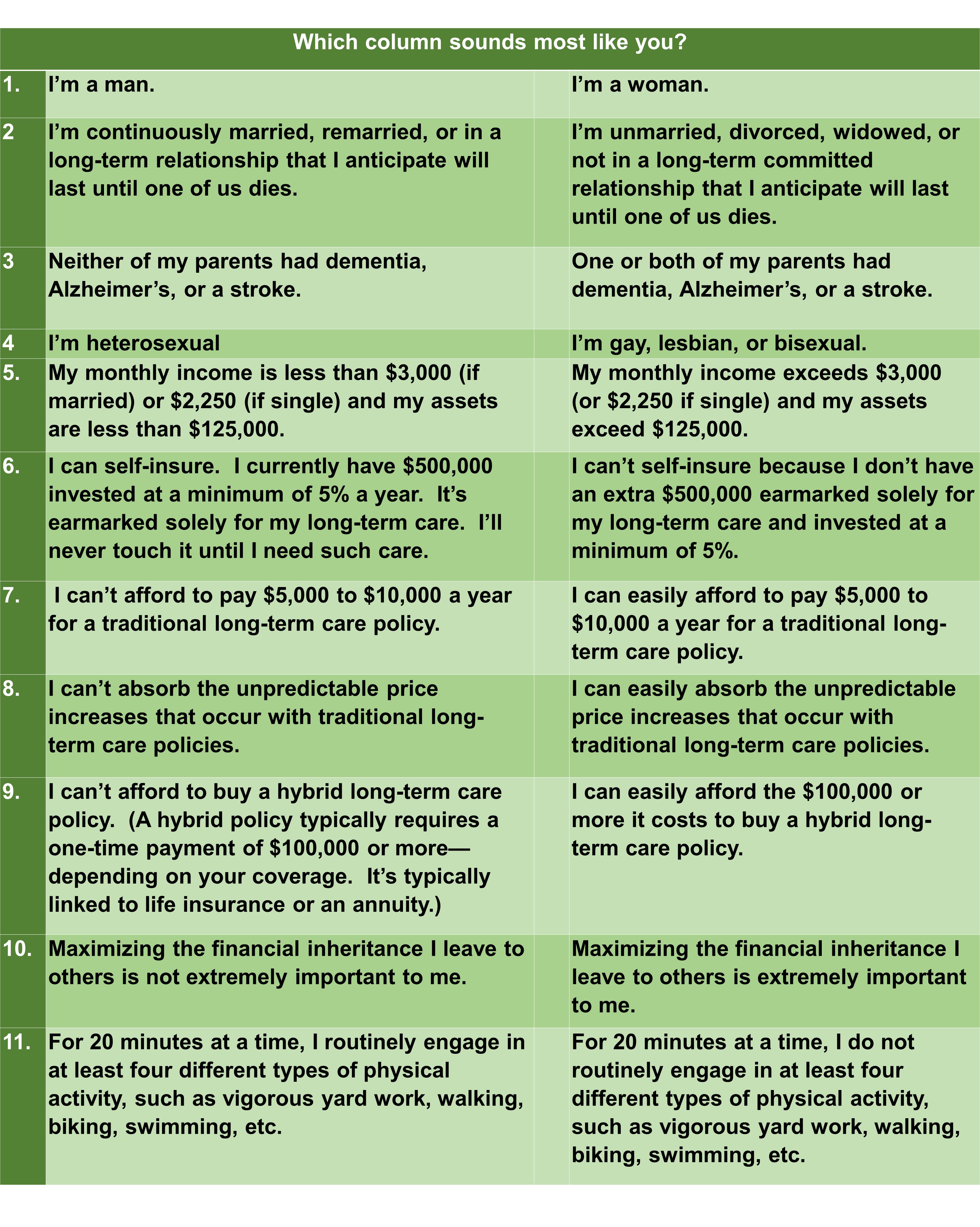
The takeaway: Plenty of people make their grand exit having never needed long-term care or long-term care insurance. The quiz below lets you know if you share the same characteristics with those who have and haven’t needed long-term care in their sunset years. Before you spend the big bucks buying long-term care insurance or self-insuring, check out the quiz, and the research behind it.
$$$
Greetings, Boomer! Rumor has it that 70% of us will need long-term care. That rumor, bandied about in official-looking reports, never seems to be accompanied by the original evidence-based-study describing how that 70% was obtained.
You can breathe (a little) easy.

Demand the science. (Or at least demand the author link to the original research.)
The actual science, which is discussed in plain terms here, shows that, on average, 77% of men and 68% of women will either never need long-term care, or will need it for less than one year. (See Table 2.) As cheery as this news may be, it still leaves a group of folks requiring care. Which group will you fall into?
That’s hard to know, but there is research and odds that can point to some clues. Check out the quize below and, for each item, decide which column best describes you.
Quiz: how likely are you to need long-term care?©BoomerMoneyandMore.com
What the self-assessment suggests.

Sorry! This isn’t assisted living.
Boomer, figuring out where you fall is a two step process.
- Step 1: look at whether you have more checks in the left or right column.
- Step 2: look at which items are most important to you.
Step 1. Look at which column has more checks.
If more checks were for items in the left-hand column, you may not need insurance for the four reasons listed below.
- You have characteristics that research shows may help you avoid long-term care; (Items 1-4).
- You either have enough money to self-insure or, conversely, you don’t have enough to buy the insurance. In the latter case, Uncle Sam may eventually pay for your care; (Items 5-9).
- You’d rather self-insure than pay thousands for expensive insurance you might not use; (Item 10).
- You have a lifestyle that research shows could stave off the need for long-term care or reduce the amount of time you’d need it. (Item 11).
Had more checks on the right side?
Then the opposite applies.
Step 2. Look at which items are most important to you.
Chances are there are one or two items on the assessment that trump all other items. For one woman, more of her answers were in the right column, suggesting she should buy the insurance. She didn’t care. She had the money to self-insure indefinitely. That’s what she was going to do. She simply refused to pay a lot of money for insurance she might never use.

“Son, there’s nothing left! We were unprepared for mom’s long-term care.” (Don’t be this guy!)
In contrast, a friend of mine had more checks in the left column, which suggested she didn’t need the insurance. Nonetheless she’s buying. Why? Because she has a special needs child. Maximizing that child’s inheritance trumps all other considerations. She wants to avoid even the potential of catastrophic long-term care costs eroding that child’s inheritance.
These are two extremes. Where do you fall on this continuum?
Still not sure? Here’s research to consider before you risk the big bucks.
Items 1-3 – Demographics & Heredity. Research shows that those in failing cognitive health need the most long-term care, men need the least, and women are between the two. Although those with a biological parent or sibling suffering Alzheimer’s or dementia may be more prone to experience these diseases themselves, there is also evidence the odds are quite small. In fact, research shows your odds of needing long-term care for more than one year are, in fact, relatively slim.

The gay community is at special risk for needing long-term care. (Research is scant for the rest of the LGBTQ+ community.)
Items 2 and 4 – LGBTQ+ community and unmarried adults not in committed long-term relationships. Some research suggests that these groups may face greater risks of needing long-term care than their counterparts due to the stress of discrimination and prejudice some of them may face.
Item 5 – Medicaid. As of this writing, Medicaid will pay your long-term care expenses if, as a single person, your monthly income is less than $2,742. As a married person, your monthly income must be less than $5,484. Regardless of your marital status, and excluding your house, you are authorized $2,000 in assets. (States differ slightly on these amounts. Check with your state’s Medicaid office.
Sidebar: Medicaid is like the US tax code: highy complex and poorly written. Those with fancy attorneys come out ahead, regardless of how the law reads to the rest of us mortals. Check out this post.
Item 6 – Self-Insure. If you choose to self-insure, having a stash of between $200,000 and $500,000 per person would be a worthy target, at today’s prices.
Items 7-9 – Insurance affordability. No need to buy if you can’t afford the premiums, the unpredictability of a traditional policy or the high cost of a hybrid policy (discussed later in this series). The advantages and disadvantages of a traditional vs. hybrid policy are discussed in a future column.
Item 10 – Inheritance. Should you self-insure and later need long-term care, you’ll reduce the inheritance you leave your kids. If this bothers you tremendously, you might want to cautiously consider buying long-term care insurance. Some types of coverage allow you to leave an inheritance to your spouse or kids. These insurance products are discussed in a future column.
Items 11 – Exercise and Dementia.

Hey! This is just one of four different exercises she does for 20 minutes. She’s reducing her risk of dementia. Be her!
Research shows that exercise delays the onset of cognitive decline if 1) you routinely engage in at least four different types of physical activity and 2) if you engage in the activity for at least 20 minutes. Specifically, such exercise is inversely related to the onset of cognitive impairment. The authors note that cognitive impairment is a common reason for needing long-term care.
Later in this series: Using the self-assessment to make good decisions.
After taking the self-assessment you may decide to shop for long-term care policies, self-insure, rely on Uncle Sam, or leave it all to chance. Have a look at the rest of the long-term care series before buying–listed below. Get the facts, protect your wallet.
You got this.
$$$
Long-Term Care Series (Oldest to Newest)
- Long-Term Care Insurance: Five Warnings Before You Buy
- Long-Term Care Insurance Quiz: Will I Need It? Can I Get It?
- 17 Ways to Get Turned Down for Long-Term Care Insurance. (And What Happened to Me.) ** Most popular post on site!
- Getting Medicaid to (Maybe) Pay for Your Nursing Home Costs: The (Updated) Epic Guide!
- Three Types of Long-Term Care Insurance: You Might Not Need Any!
- Continuing Care Retirement Communities Part 1 —Seven Essential Things to Know
- Continuing Care Retirement Communities Part 2 — Four Ways to Figure Out if They’re Worth the Money
- Continuing Care Retirement Communities, Part 3 — What to Ask Before Signing on the Dotted Line.
- Staring Down Your Long-Term Care Odds–Much Better News Than You Thought.
- How to Evaluate a Long-Term Care Policy. (Hint: Know These Three Things.)
- The Three Factors Affecting Your Long-Term Care Insurance Costs.
- My Encounters in the Wild With Long-Term Care Sales Agents.My Encounters in the Wild With Long-Term Care Sales Agents.
- Self-Insuring Your Long-Term Care. (Almost) Everything You Wanted to Know but Were Afraid to Ask.
Notes.
Favreault, Melissa and Dey, Judith. “Long-Term Services and Supports for Older Americans: Risks and Financing Research Brief.” U.S. Department of Health and Human Services: Office of the Assistant Secretary for Planning and Evaluation. Revised 2016.
Thomeer, Mieke Beth; Mudrazija, Stipica; Angel, L. Jacqueline. “Relationship Status and Long-Term Care Facility Use in Later Life.” U.S. National Library of Medicine National Institute of Health, 2015. — (Also published in The Journals of Gerontology: Series B, Vol. 71, No. 4, pgs. 711-723, 2016.)
Goldman, Jill S.; Hahn, Susan E.; Cantania, Jennifer Williamson; LaRusse-Eckert, Susan; Butson, Melissa Barber; Rumbaugh, Malia; Strecker, Michelle N.; Roberts, J. Scott; Burke, Wylie; Mayeaux, Richard; Bird,Thomas. “Genetic counseling and testing for Alzheimer disease: joint practice guidelines of the American College of Medical Genetics and the National Society of Genetic Counselors.” U.S. National Library of Medicine National Institute of Health, 2012 — (Also published in Genetic Medicine, Vol. 13, No. 6, pgs. 597-605, 2011.)
Taylor, Matthew; Rutten-Jacobs, Loes C.A.; Holliday, Elizabeth G; Malik, Rainer; Sudlow, Cathie; Rothwell, Peter M.; Maguire, Jane M.; Koblar, Simon A.; Bevan, Steve; Boncoraglio, Giorgio; Dichgans, Martin; Levi, Chris; Lewis, Cathryn M.; Markus, Hugh S; “Differences in Common Genetic Predisposition to Ischemic Stroke by Age and Sex.” U.S. National Library of Medicine National Institute of Health, 2015. — (Also published in Stroke, Vol. 46, No. 11, pgs. 3042–3047, 2015.)
Hiedemann,Bridget and Brodoff, Lisa. “Increased Risks of Needing Long-Term Care Among Older Adults Living With Same-Sex Partners.” U.S. National Library of Medicine National Institute of Health, 2015. 2013 — (Also published in American Journal of Public Health, Vol.103, No. 8, pgs. 27-33, 2013.)
Henning-Smith, Carrie; Gonzales, Gilbert; Shippee, Tetyana P. “Differences by Sexual Orientation in Expectations About Future Long-Term Care Needs Among Adults 40 to 65 Years Old.” U.S. National Library of Medicine National Institute of Health, 2015. — (Also published in American Journal of Public Health, Vol. 105, No. 11, pgs. 2359-2365, 2015.)
Perry, Mo. “The Challenge of Being Transgender in a Nursing Home.” The Atlantic, August 12, 2015.
Jedrziewski, M. Kathryn; Ewband, Douglas C.; Wang, Haidong, Trojanowski, John Q. “Exercise and Cognition: Results from the National Long-Term Care Survey.” U.S. National Library of Medicine National Institute of Health, 2010. — (Also published in Alzheimers & Dementia: The Journal of the Alzheimer’s Association, Vol. 6, No. 6, pgs. 448-455, 2010.)
Cornell, P.Y, Grabowski, D.C, Cohen, M, Shi X, Stevenson, D.G. “Medical Underwriting in Long-Term Care Insurance: Market Conditions Limit Options for Higher-risk Consumers.” U.S. National Library of Medicine National Institute of Health, 2016. — (Also published in Health Affairs, Vol. 35, No. 8, pgs. 1494–1503, 2016.)
$$$
